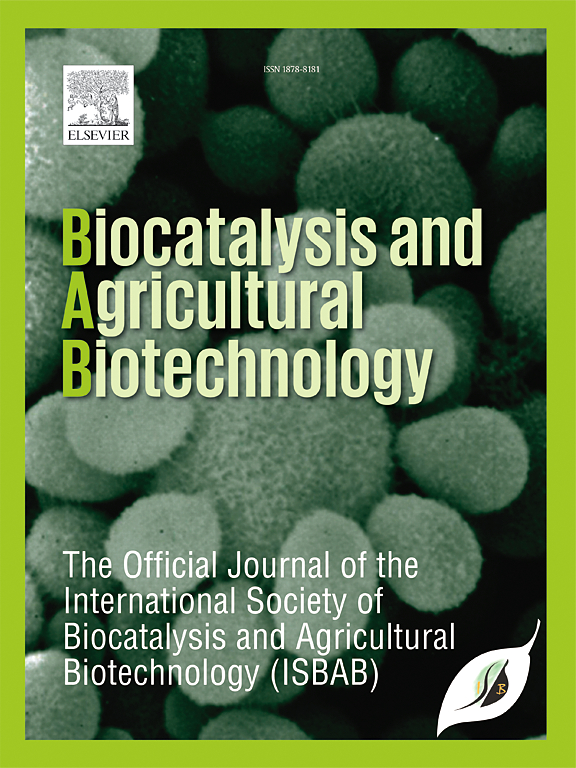Comparative metagenomic analysis of rice phyllosphere bacterial communities under semi-organic and non-organic farming systems
IF 3.8
Q2 BIOTECHNOLOGY & APPLIED MICROBIOLOGY
引用次数: 0
Abstract
In the global cultivation of rice (Oryza sativa L.), synthetic fertilizers and pesticides are used to increase yield and manage pests and diseases. Intensive agriculture disrupts native microbial populations including those in the phyllosphere. This study used metagenomic analysis to compare the diversity and composition of phyllosphere bacterial communities in rice cultivated in semi-organic and non-organic systems. The analysis identified 38 phyla, 76 classes, 166 orders, 343 families, 732 genera, and 1094 bacterial species. Although both systems shared a similar taxonomic composition from the phylum to genus level, the semi-organic samples showed slightly higher microbial diversity and evenness. The most dominant phylum in both cultivation systems was Cyanobacteriota. Bacilliota, Pseudomonadota, and Fusobacteriota were more abundant in the semi-organic system. The dominant species in both systems Thalassoporum komareki, Holzapfeliella floricola, Cyanothece aeruginosa, and Idiomarina baltica, are associated with ecological functions such as photosynthesis, nitrogen fixation, and organic matter decomposition. Semi-organic farming also resulted in a lower relative abundance of putative pathogens, including Xanthomonas oryzae, Burkholderia glumae, Pseudomonas fuscovaginae, and Pantoea ananatis, suggesting that a more balanced microbial community may help suppress pathogens. These findings suggest that semi-organic farming practices have the potential to support a more ecologically stable phyllosphere microbiome, which may, in turn, contribute to improved plant health. Further research is needed to explore the ecological functions and interactions of phyllosphere microorganisms in sustainable rice-cultivation systems.
半有机与非有机耕作制度下水稻层圈细菌群落的宏基因组比较分析
在水稻(Oryza sativa L.)的全球种植中,使用合成肥料和农药来提高产量和防治病虫害。集约化农业破坏了原生微生物种群,包括层圈内的微生物种群。本研究采用宏基因组分析方法,比较了半有机和非有机栽培水稻层球细菌群落的多样性和组成。共鉴定出38门76纲166目343科732属1094种细菌。虽然两个系统在门到属的分类组成上相似,但半有机样品的微生物多样性和均匀性略高。在两种培养系统中最占优势的门是蓝藻门。半有机系统中杆菌门、假单胞菌门和梭杆菌门数量较多。在这两个系统中,优势种分别是海孢藻(Thalassoporum komareki)、floricola Holzapfeliella、青铜绿藻(Cyanothece aeruginosa)和波罗地海藻(Idiomarina baltica),它们具有光合作用、固氮和有机物分解等生态功能。半有机农业也导致了相对较低的假定病原体丰度,包括米黄单胞菌、金黄色伯克氏菌、fuscovagin假单胞菌和Pantoea ananatis,这表明一个更平衡的微生物群落可能有助于抑制病原体。这些发现表明,半有机农业实践有可能支持生态更稳定的层圈微生物群,这反过来可能有助于改善植物健康。水稻可持续栽培系统中层圈微生物的生态功能及其相互作用有待进一步研究。
本文章由计算机程序翻译,如有差异,请以英文原文为准。
求助全文
约1分钟内获得全文
求助全文
来源期刊

Biocatalysis and agricultural biotechnology
Agricultural and Biological Sciences-Agronomy and Crop Science
CiteScore
7.70
自引率
2.50%
发文量
308
审稿时长
48 days
期刊介绍:
Biocatalysis and Agricultural Biotechnology is the official journal of the International Society of Biocatalysis and Agricultural Biotechnology (ISBAB). The journal publishes high quality articles especially in the science and technology of biocatalysis, bioprocesses, agricultural biotechnology, biomedical biotechnology, and, if appropriate, from other related areas of biotechnology. The journal will publish peer-reviewed basic and applied research papers, authoritative reviews, and feature articles. The scope of the journal encompasses the research, industrial, and commercial aspects of biotechnology, including the areas of: biocatalysis; bioprocesses; food and agriculture; genetic engineering; molecular biology; healthcare and pharmaceuticals; biofuels; genomics; nanotechnology; environment and biodiversity; and bioremediation.
 求助内容:
求助内容: 应助结果提醒方式:
应助结果提醒方式:


